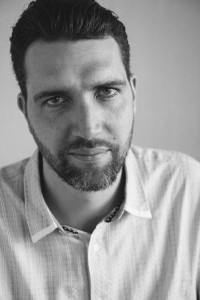
Vikings, History Channel’s hit mini-series, is a lush adventure saga about a tribe of medieval Norsemen who ventured west into unknown waters and landed in the south of England where they pillaged and conquered. The 10-episode second season recently concluded airing, and a third season, to be shown in 2015, is about to start filming. Once again it will be shot in Ireland at the Ashford Studios on the outskirts of Dublin.
Last year, the first season of Vikings was nominated for three Emmys for outstanding special visual effects in a supporting role, outstanding main title design and outstanding sound editing for a series.
Computer graphics and visual effects – applied initially and still most frequently to the plethora of sci-fi superhero movies – have in recent years become an important production component of the large number of television series that are part of the increasingly popular genre of embellished or fantasy history. Some current offerings include HBO’s Game of Thrones, Da Vinci’s Demons on Starz and also Vikings. The latter is loosely based on the exploits of Ragnar Lothbrok, a hero out of Scandinavian mythology and history, played by Australian actor Travis Fimmell.
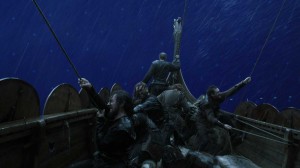
Typically, CGI is used in such shows to extend sets, create elaborate building interiors, add numbers to crowds, enhance battle scenes and add to the plentiful gore and blood. On top of all that, for Vikings, realistically simulating the ocean was one of the main tasks for the special effects team, supervised by Dominic Remane, especially in the dramatic storm sequence that tosses the boats of the warriors as they head westward.
“Water for sure was one of the biggest challenges in Season 2,” said Remane, who works for Mr. X, the large Toronto-based VFX house that created nearly all of the special effects. (Mr. X is being purchased by Technicolor, it was recently announced). “The producers really wanted to portray the violence and the brutality of crossing the North Sea and the dangers that come with it,” he noted. “We were tasked with this massive storm where some of the Vikings would eventually perish against the rocks. Technically we spent a lot of time figuring out the best system to use, and developing a look that appeared as real as possible.”
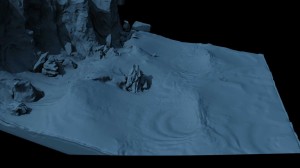
Realflow, the software much of the industry uses for simulations of ocean and water, was used on Vikings. “But we developed our own internal system for the ocean surface and for how the foam reacts and moves and dissolve,” he noted. “We spent a lot of time on that, a technology, knowing it will be used in future seasons and different productions that Mr. X does.”
No water tanks were used. In the storm sequence, the actors in their boat were raised up on a gimbal on a set in the studio, a hydraulic system that moved the ship back and forth and left and right, to give the sense of lurching motion on the water. “The actors were also sprayed with water, and special effects were used to add more rain elements, thicker splashes and the ocean itself,” Remane added. Also extra boats were added to the handful of actual ships, so the Viking fleet looked much larger.
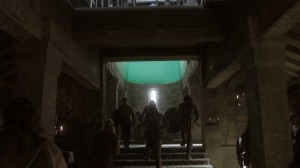
Ireland, where Vikings was shot, “doesn’t have the great fjords they have in Norway, so we took a lot of plates there for both season 1 and 2 and did quite a lot of enhancement to make sure both the fjords were grand as well as the cliffs in England,” he said.
For season 2, the town where the tribe of Vikings live was expanded substantially. Five buildings were constructed on location, but CGI increased that number to 60. “We also had to add people to show it was alive,” he noted. The exteriors for the realm of Lagerta was basically created from scratch, including wide establishing shots with doors to buildings that the characters walked in and out of. Interiors were mainly the purview of the production designers. But the bell tower to Winchester Abbey which was raided had two stories added to it.
Then there were several big battle sequences. Real arrows weren’t allowed to be used, so digital arrows flew from bows along with digital spears flying through the air. Soldiers were also added to make the armies seem larger. All of this, along with the rest of the CGI enhancement appeared seamless.
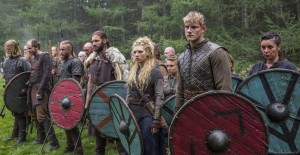 Though elaborate and extensive, the VFX workflow was hectic but not harried. “About five weeks of prep took place where we talked about how we were going to film the big special effects scenes and minimize any problems,” said Remane. The 10 episodes of season 2 were divided into five blocks, each consisting of two shows per director, so a number of episodes could go forward simultaneously. The VFX supervisor spent several weeks in Ireland at the beginning of the shoot, and then returned to Canada for the remainder. “By the time got to episode 5 we were already doing postproduction in Toronto,” he noted.
Though elaborate and extensive, the VFX workflow was hectic but not harried. “About five weeks of prep took place where we talked about how we were going to film the big special effects scenes and minimize any problems,” said Remane. The 10 episodes of season 2 were divided into five blocks, each consisting of two shows per director, so a number of episodes could go forward simultaneously. The VFX supervisor spent several weeks in Ireland at the beginning of the shoot, and then returned to Canada for the remainder. “By the time got to episode 5 we were already doing postproduction in Toronto,” he noted.
“Because we spent so much time in prep, we were able to make sure that everything was shot the way we needed,” he observed. “So there wasn’t any crazy overtime or any frantic running around. It was actually quite a smooth operation and I was quite happy with that.”
Vikings was the first television show Mr. X had taken on. Previously it had only done movies, working on recent films like RoboCop, Pompeii and The Secret Life of Walter Mitty. Since Vikings, it has attracted more television work including Penny Dreadful on HBO. It is currently doing VFX for Marco Polo, another historic series, which will air on Netflix, and the Guillermo del Toro series The Strain which is currently filming. It will be interesting to see how the company’s future plays out now that it has been bought by Technicolor.





